Let’s talk about sweat baby! Chances are you use some form of antiperspirant or deodorant every day. If you reached puberty sometime in the 90’s or 2000’s you likely remember the Girl’s Teen Pack Personal Grooming Kit that came with your first stick of deodorant, and if you’re anything like me, you stuck loyally to that stick well into adulthood.
And now you’re on your skin-healing journey, making changes to your diet and lifestyle, and starting to get woke to the different ingredients that linger in your personal care products and what they could be doing to your body and contributing to your adult acne.
When I first started to make the switch to more natural and safer skin care and body products, I started with my deodorant. And now that I work with clients who are making holistic changes to manage their acne, they typically find that trying and switching deodorants is a simple, no-brainer place to start.
NATURAL DEODORANTS ARE LIKE THE GATEWAY DRUG TO NATURAL, SAFER SKIN AND BEAUTY PRODUCTS.
So if you want to get the complete low down on Natural Deodorants then this Ultimate Guide to Making the Switch it Natural Deodorant is for you!
ULTIMATE GUIDE CONTENTS
Why choose natural deodorant?
Questionable Ingredients in Antiperspirant
Comparing Ingredients Across 3 Popular Antiperspirant/Deodorant Brands
What to expect when switching?
Buying vs. Making your own deodorant
Recommended natural deodorants to try & buy
How to make your own natural deodorant (video & recipe)
Why Choose Natural Deodorant?
Sweating is a completely natural, and necessary process. It helps regulate your body’s temperature and remove toxins from the body through the skin. Yet, whether it’s visibly seeing sweat stains, or perhaps you are prone to a particular musk when you sweat, culturally we have been conditioned to be embarrassed by our sweat.
So it seems like a perfectly reasonable solution to reach for an antiperspirant and try and stop sweating before it even starts. But the trouble with conventional antiperspirants is that they use aluminum as a means to block the sweat ducts and prevent sweating altogether.
This can be problematic because not only are you stifling one of your body’s natural detoxification pathways, but you are increasing the likelihood of your body absorbing the aluminum. Aluminum may seem innocuous, but it is believed to be linked to both Alzheimer’s and certain cancers in the body, specifically breast cancer. [1]
Since there are so many great natural deodorant options, and it’s so easy to make your own, switching from an antiperspirant to a natural deodorant is a really simple and easy to implement lifestyle change.
Questionable Ingredients in Antiperspirant
ALUMINUM
Aluminum is known to have a genotoxic profile, capable of causing both DNA alterations and epigenetic effects, and this would be consistent with a potential role in breast cancer if such effects occurred in breast cells. [2]
A little aluminum in your deodorant may seem like a small price to pay to avoid any embarrassment that comes with sweating, however, it’s important that when trying to support your body and hormones to reverse and prevent acne, that we consider the cumulative effects of our exposure to toxins in our products, environment, and foods, as it’s the build-up over time that will burden the body and cause imbalances.
But, aluminum isn’t the only questionable ingredient that you will find in your conventional deodorant. Read on to learn about a few others you should keep your eyes open for.
POLYETHYLENE OR PEG COMPOUNDS
PEGs are widely used in cosmetics as thickeners, solvents, softeners, and moisture-carriers. According to the Cosmetic Ingredient Review (CIR) committee, PEGs are often contaminated with known carcinogens such as ethylene oxide, 1,4 dioxane, and heavy metals including arsenic, cadmium, lead, nickel, cobalt and iron. This ingredient can not only damage the skin, but it counteracts the skins defence mechanisms against antimicrobials. By increasing skin permeability and allowing pollutants to enter the body through the skin’s surface, we are susceptible to a variety of issues that arise from chemical contamination.
PROPYLENE GLYCOL (PG)
Propylene glycol is a synthetic liquid substance that absorbs water. On the surface it seems like a great ingredient for a deodorant, and in recent studies, propylene glycol is considered to be “non-toxic” to the body when ingested, however, there have been reports on its potential toxicity, linking it to issues such as:
- cancer
- reproductive complications
- developmental abnormalities
- neurotoxicity
- endocrine complications
Propylene Glycol has one main concern being that it is a skin sensitizer, resulting in allergic reactions in the skin including irritant contact dermatitis, allergic contact dermatitis and non-immunologic contact urticaria (hives).
PHTHALATES
Phthalates are endocrine disruptors often also found in plastic that can cause hormone imbalance. Once phthalates are absorbed by the body, they act as estrogens, which not only conflict with your hormonal function, but cause a variety of complications, such as infertility, endometriosis, asthma, and allergies. They often do not appear directly on the ingredients label as they tend to hide under the “fragrance” listing.
FRAGRANCE / PARFUM
Yes, you likely want your deodorant to leave you smelling like a fresh spring day, but synthetic fragrances can give you more than what you bargained for. Fragrance or parfum in deodorant is an engineered scent or flavouring agent that may contain any combination of 3,000-plus stock chemical ingredients, including hormone disruptors and allergens. The scary thing is that we can never really know what constitutes “fragrance” on a label, as formulas are protected under federal law’s classification of trade secrets and therefore can remain undisclosed.
Comparing Ingredients Across 3 Popular Brands
I made a trip to my neighbourhood drugstore and picked up three of their most prominently displayed deodorants. To give you a sense of how the ingredients are listed on the products, check out the images below.
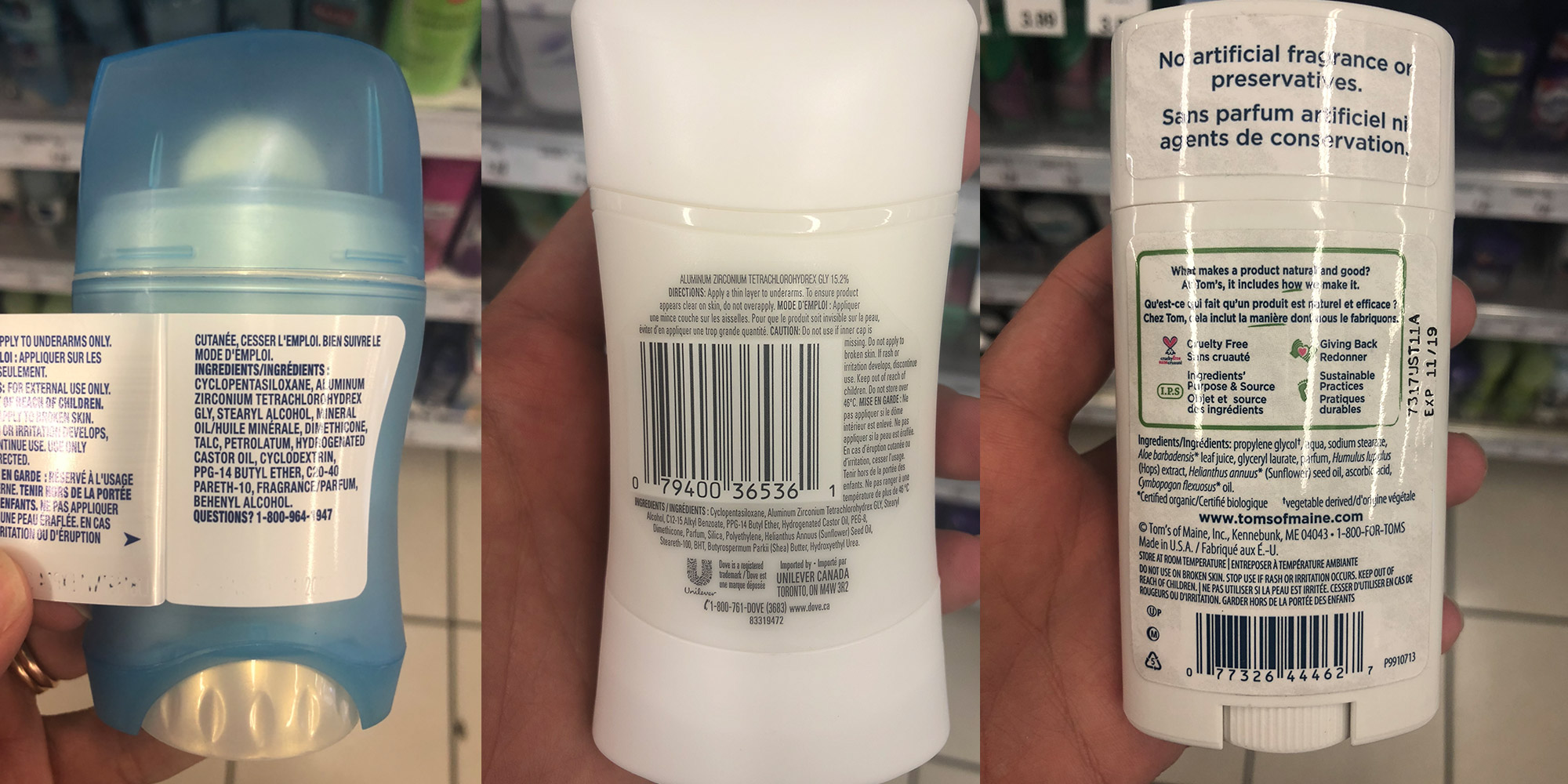
That is A LOT of ingredients to try and wrap your head around. So to help you, even more, I went one step further and looked up every single ingredient on the Environmental Working Group’s Skin Deep Database to get a sense of how each individual ingredient can affect the balance of our bodies’ systems. I’ve listed each ingredient, its EWG rating, and the ingredients’ effect on the body in this handy-dandy reference chart.
This information isn’t intended to scare you into switching to a more natural deodorant, but to inform you of what’s really going into the products you use on your body, and the potential long-term harm they may cause. As a holistic health advocate and educator, it’s my role to help you understand these risks so that you can choose to make informed decisions when it comes to reclaiming balance in your body and your skin.
Even if you’re like me and need to have ALL the facts before making a larger lifestyle change, the switch to natural deodorant is so simple, effective and affordable, that it can be one of the biggest no-brainer things you do for your overall health.
What to expect when switching?
Ok, real talk for a second: Making the switch from conventional antiperspirants to natural deodorant can potentially be a smelly (but temporary) process.
Why? As it turns out that the repeated use of antiperspirant over years can actually change the bacterial microbiome in your armpits, and can make your sweat smellier due to an overproduction of bad bacteria if you briefly discontinue use. [3]
Many people refer to this time period as a “deodorant detox”, and while it may be a little unpleasant, it’s 100% worth sticking it out. And this makes sense, after all, it’s not your sweat specifically that stinks, but it is the sweat, mixed with the specific bacteria on your underarms that is going to cause an unpleasant odour.
4 THINGS YOU CAN DO DURING THIS TRANSITION PHASE TO HELP WITH THE DETOX:
- Drink lots of water.
- Wear natural fiber clothing such as cotton, hemp or bamboo.
- Fill your diet with plenty of leafy greens and gentle-detoxifying foods. Some foods that can help with detox from the inside out include:
- Herbs: parsley, mint, cilantro, basil
- Spices: cloves, caraway, cinnamon
- Probiotic-rich foods: naturally fermented sauerkraut, pickles, yogurt
- Plant algaes: chlorella, spirulina, and liquid chlorophyll.
- Apply your natural deodorant 2-3 times per day.
Everybody is different, but a pit “detox” period can last anywhere between 1-4 weeks. In the beginning, you may experience a temporary increase in perspiration, as your sweat glands in your armpits get reacquainted with the process of sweating. This excess will eventually normalize over the coming weeks.
Buying vs. Making Your Own Natural Deodorant
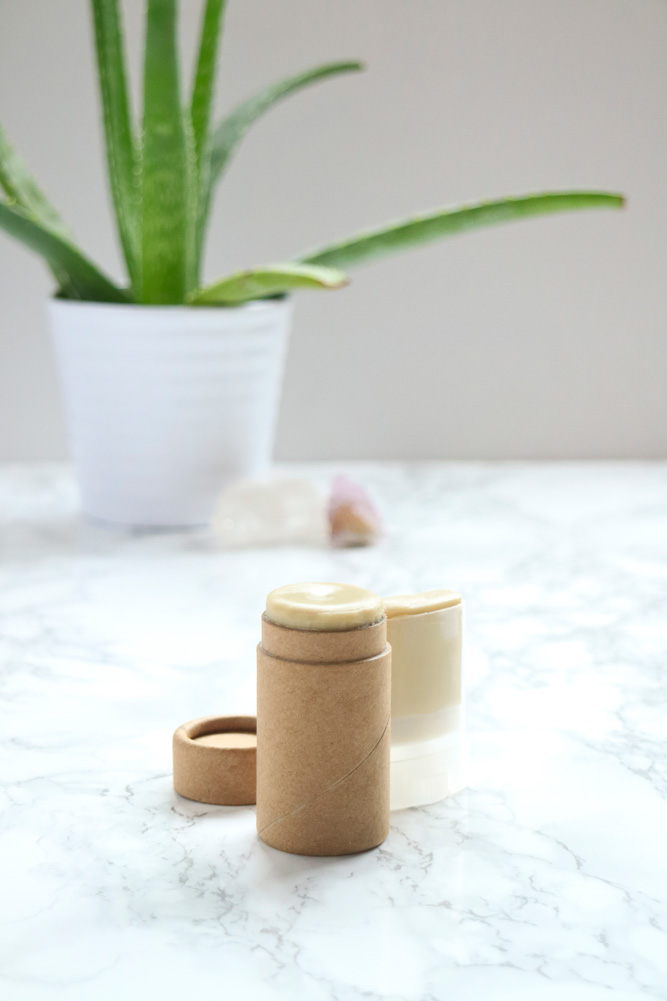 In North America, we live in a very special time where access to natural alternatives to deodorant is not difficult to come by. If your local natural health-food store does not carry a brand that works for you, then there are a plethora of options easily available for purchase both on Amazon and other sites like well.ca.
In North America, we live in a very special time where access to natural alternatives to deodorant is not difficult to come by. If your local natural health-food store does not carry a brand that works for you, then there are a plethora of options easily available for purchase both on Amazon and other sites like well.ca.
Etsy and Instagram are also awesome places to find natural formulations by smaller brands. On Instagram use a hashtag such as #naturaldeodorant and you’ll be well on your way with over 83,000+ posts of people recommending and selling their favourite brands.
Whether you are buying a natural deodorant online or making your own, my biggest advice is to make sure that the ingredients of the formula or the recipe are clearly listed. There are some common natural ingredients that are included in safer forms of deodorant that are actually not that safe for the pH balance of your skin, and could actually make your armpits a red, bumpy, rashy mess. No bueno!
So even if a deodorant is said to be “natural”, you’ll want to be on the lookout for these top 2 irritating ingredients:
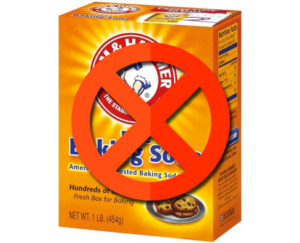 Baking Soda. It seems innocuous. Heck, you likely even bake with it on the regular. So how can baking soda be problematic in your deodorant? Well, it is extremely alkaline, and your skin is naturally acidic, therefore disrupting the natural pH balance of your skin’s acid mantle and resulting in a painful rash. Baking soda is probably the most common natural active ingredient in safer deodorants, yet it can be problematic for so many people.
Baking Soda. It seems innocuous. Heck, you likely even bake with it on the regular. So how can baking soda be problematic in your deodorant? Well, it is extremely alkaline, and your skin is naturally acidic, therefore disrupting the natural pH balance of your skin’s acid mantle and resulting in a painful rash. Baking soda is probably the most common natural active ingredient in safer deodorants, yet it can be problematic for so many people.
Instead, Look For: Better, alternative active ingredients to baking soda include diatomaceous earth and magnesium as they are both close to our skin’s natural pH.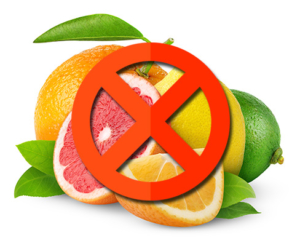 Citrus essential oils. These include lemon, grapefruit, lime, bergamot, tangerine, and neroli – just to name a few! While they can smell absolutely energizing and delightful, these specific essential oils can be problematic because they can increase photosensitivity in the skin. In the winter months these essential oils may be totally fine, but if you’re in a warm, sunny climate where you’re often rocking a tank top, then regular use of these essential oils on a sensitive part of your body, like your armpits, could result in a rash.
Citrus essential oils. These include lemon, grapefruit, lime, bergamot, tangerine, and neroli – just to name a few! While they can smell absolutely energizing and delightful, these specific essential oils can be problematic because they can increase photosensitivity in the skin. In the winter months these essential oils may be totally fine, but if you’re in a warm, sunny climate where you’re often rocking a tank top, then regular use of these essential oils on a sensitive part of your body, like your armpits, could result in a rash.
Instead, Look For: Essential oils that are safer, smell divine and can help with deodorizing your armpits include lavender, tea tree, peppermint, and clary sage. Citronella and lemongrass are both excellent essential oils that not only provide a citrus scent but are also great for cases of excessive perspiration.
And if a natural deodorant doesn’t fully list all their ingredients, then consider this a red flag and move on. Full transparency is what we’re after, and it’s brands and makers that embrace this value, who I feel we should be supporting.
Recommended Natural Deodorants to Try & Buy:
Asking the Internet to share their favourite natural deodorant brands is like opening up Pandora’s box! It seems that so many of us who are passionate about holistic living have done our due diligence and have tested countless of deodorants until we found the perfect one that works for us. And like many things, when we find something we love and use all the time, we generally have strong opinions and want to share them with the rest of our community.
Here are three of the most popular safer deodorant brands I have seen recommended online by my fellow holistic nutritionist community:
Routine Natural Deodorant – 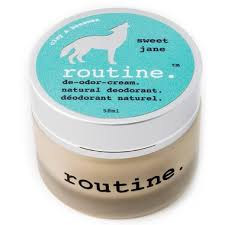 If you like your deodorant as a cream, then Routine might be what you’re looking for. Created by two sisters who were on the search for a clean and stylish natural deodorant that actually worked, led them to the creation of their own deodorants that they felt they just had to share with the world. Routine has a pretty big variety of scents with fun names such as “Sexy Sadie” and “A Girl Named Sue”. They also offer vegan options that don’t have beeswax, plus sensitive skin options that use magnesium instead of baking soda. Be sure to read their full ingredients for each product, as they do vary!
If you like your deodorant as a cream, then Routine might be what you’re looking for. Created by two sisters who were on the search for a clean and stylish natural deodorant that actually worked, led them to the creation of their own deodorants that they felt they just had to share with the world. Routine has a pretty big variety of scents with fun names such as “Sexy Sadie” and “A Girl Named Sue”. They also offer vegan options that don’t have beeswax, plus sensitive skin options that use magnesium instead of baking soda. Be sure to read their full ingredients for each product, as they do vary!
Saje Deodorant Spray – 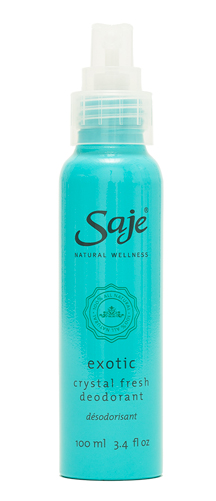 If you prefer your deodorant as a spray, you will love Saje Wellness’ Crystal Fresh Deodorant Sprays. Saje says they are “natural, mineral salt-based deodorants that keep you fresh while letting your skin breathe.”
If you prefer your deodorant as a spray, you will love Saje Wellness’ Crystal Fresh Deodorant Sprays. Saje says they are “natural, mineral salt-based deodorants that keep you fresh while letting your skin breathe.”
Schmidt’s Naturals – 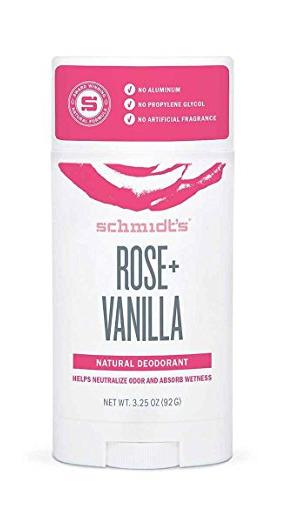 Schmidt’s award-winning formulas use innovative ingredients derived from plants and minerals. If you love a stick deodorant (like me!), then you’ll love Schmidt’s. They have a ton of scent options, but some of their products do contain baking soda so it might not be right for your skin. Instead, opt for one of their sensitive skin formulas, which uses magnesium instead of baking soda. I love that they have little travel/trial sizes, which can be great when you want to test them out or try a few different scents!
Schmidt’s award-winning formulas use innovative ingredients derived from plants and minerals. If you love a stick deodorant (like me!), then you’ll love Schmidt’s. They have a ton of scent options, but some of their products do contain baking soda so it might not be right for your skin. Instead, opt for one of their sensitive skin formulas, which uses magnesium instead of baking soda. I love that they have little travel/trial sizes, which can be great when you want to test them out or try a few different scents!
How to Make Your Own Natural Deodorant
DIYing your own deodorant is totally my jam. I LOVE it and have been doing it for years. In fact, I can’t remember the last time I bought a full stick of deodorant from the store. With just a few simple ingredients and some upcycled containers, you can make months, to years-worth of deodorant very affordably!
To round off this Ultimate Guide to Making the Switch to Natural Deodorant, I want to share with you my tried-and-true recipe and video instructions so you can start making it yourself.
I have to warn you though, making your own deodorant can be a slippery slope into the world of DIY skin care! (That’s a cheeky warning, btw.)
That’s why I also have an 8-part video course all about how to make natural, safer skin care products! This deodorant recipe and video is from this course, so consider it my gift and free preview to you!
The Recipe
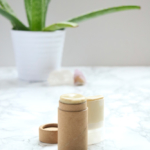
Natural DIY Stick Deodorant (Baking Soda Free)
A stick deodorant used with all natural ingredients and zero baking soda! Perfect for sensitive skin!
Ingredients
Recommended Equipment
- Scale
- Small pinch bowls for ingredients
- Heat-resistant glass measuring cup
- Small pot or pan for water bath
- Mixing spoon or spatula
- Empty new or up-cycled deodorant stick tube
Ingredients by weight (Percentage provided to scale recipe)
- 18 g Coconut Oil (30%)
- 16 g Mango Butter (27%)
- 11 g Beeswax Pastilles (18%)
- 7 g Diatomaceous Earth (12%)
- 7 g Arrowroot Powder (12%)
- 10 drops Essential Oils (Optional) (1%)
Instructions
-
Prepare a water bath in a wide, flat-bottomed pan, by bringing 1 inch of water to a bare simmer over low - medium heat.
-
Weigh the coconut oil, mango butter, and beeswax to the small heatproof glass measuring cup, and place in the water bath. As the oils and wax begin to melt, stir with a spoon or spatula.
-
When the oils and wax are fully melted, add the diatomaceous earth and arrowroot powder to the wet ingredients, and stir until well combined.
-
Remove the glass bowl from the heat, and allow to cool for 1 minute on the counter.
-
Add any optional essential oils at this time, and stir to combine.
-
Pour the slightly cooled liquid deodorant into your deodorant stick packaging of choice.
Recipe Video
Recipe Notes
This recipe recommends measuring the ingredients by weight for the most accurate results. Ingredient percentages are also provided to scale the recipe.
Still not sure about making your own?
I get it! If you don’t already have the ingredients on-hand, then it can seem like a daunting task to gather everything and try this for yourself. So just in case you need a bit more convincing, I asked a few of the ladies who have done my DIY Skin Care Workshops to share their thoughts on the deodorant:
“I’ve tried quite a few “natural deodorants” over the years and gotten by without being fully satisfied. That was until I tried the Skinspired DIY deodorant recipe. It was a lot of fun for me to make my own armpit product, knowing I could fully trust in its clean ingredients and also in its efficacy. Plus I love the personalized smell – my fave combo is lavender + clary sage – but I love the fact that at any time I can swap out essential oils and change up my scent. Thank you Aly!” – LUCIE
“I loved the deodorant we made. I have hyper-reactive skin and it was great to use something that my armpits didn’t react to and also worked as an effective deodorant (usually I have to compromise one or the other- rash or stinky) it’s actually why I bought another kit from you- though I never got the same scent combo to smell as nice as that first one!” – EMILY
“Aly has created amazing skin products and the recipes are easy to follow! She has found the perfect combination of natural ingredients and essential oils!” – SOLEIL
Is there anything else you’d like to know about making the switch to natural deodorant for your health?
I’d love to hear from you! Leave a comment below with your question and I’ll get back to you or answer it in this ultimate guide!



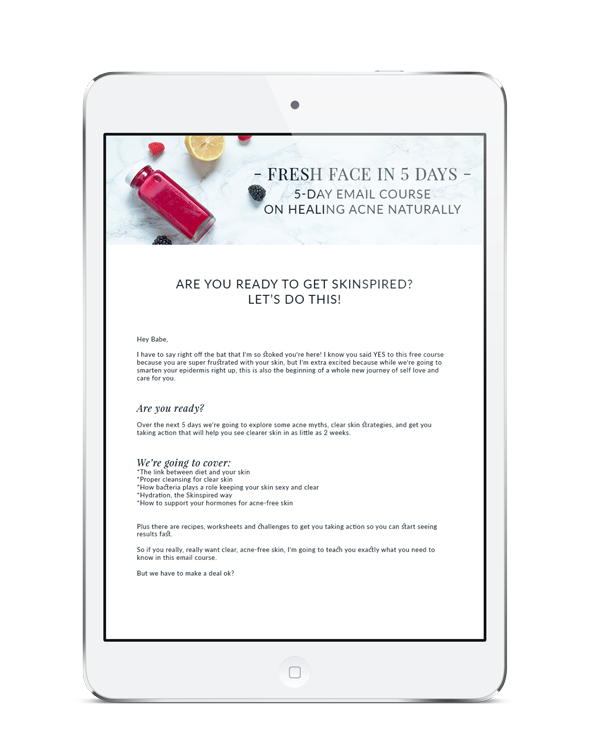
Leave A Comment